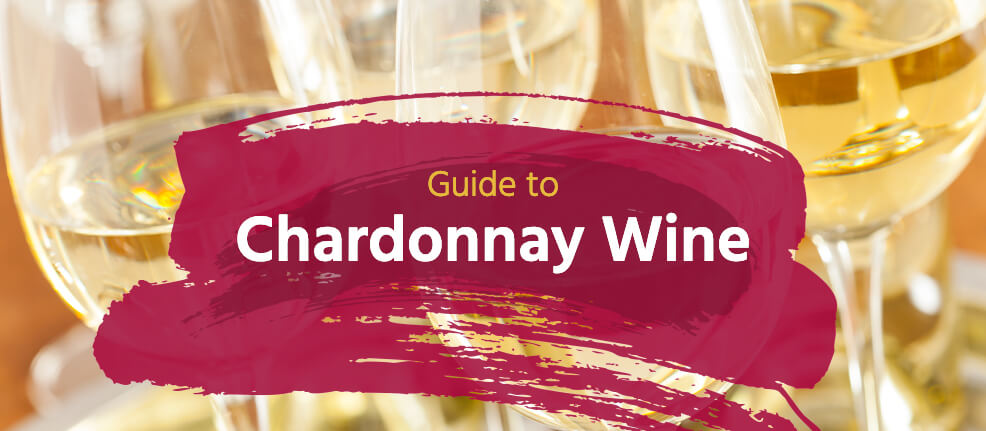
Chardonnay is the most popular white wine type in the world for a reason. Its fruity-yet-acidic balance, versatile, subtle palates and approachable pairings make chardonnay an effortless crowd-pleaser. Oh, and it’s grown in just about every major wine region in the world. Sips transport you through the golden sprawls of California to the breezy, ocean-lined vineyards of South Africa to the foggy hills of Burgundy, France, no passport required.
Pervasive pop-culture jabs aside, the universality of chardonnay grapes make them a winemaker’s dream blank canvas. It’s also led to an impressive blossoming of different types of chardonnay, each distinct in flavor profiles.
Grab your corkscrew and let us guide you through the tastes, styles and pairings of this distinct varietal.
Table of Contents
- Chardonnay Wine History
- What Does Chardonnay Taste Like?
- How Many Calories in a Glass of Chardonnay?
- 7 Types of Chardonnay
- What Does Chardonnay Pair With?
- Order Chardonnay Online
What Kind of Wine Is Chardonnay?
Chardonnay is a popular type of white wine planted and enjoyed in every major wine appellation around the world.
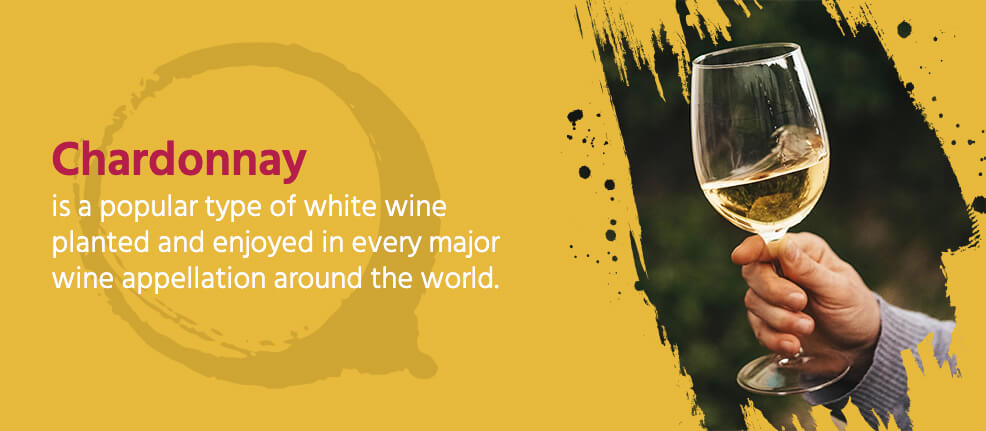
Its global appeal is twofold. First, chardonnay grapes grow on a hearty, adaptive plant that tolerates both heat and cold alike. Its versatility made it a natural choice for winegrowers looking to plant a white wine varietal in soil types or climates hostile to most others. Second — and equally as important — chardonnay grapes themselves are relatively neutral. Flavors and aromas that come to mind regarding chardonnay are actually a byproduct of its vinification processes, or how the winemaker chooses to treat the grapes during and after fermentation.
Overall, there are three major characteristics defining chardonnay:
- Oaked versus unoaked: Oaking is a fermentation process commonly applied to some red and white wines. Winemakers choose to age chardonnay in oak for several reasons, including to deepen its color, round out its natural acidity and impart more complex flavors into the drink. In contrast, unoaked chardonnay retains a higher acidity and has a lighter hue.
- Malolactic fermentation (MLF): Malolactic fermentation is a vinification process where malic acid naturally found in grapes gets tamed into smoother, softer lactic acid. The result is a creamy, notoriously “buttery” flavored wine. Chardonnays are one of the main types of white wine to undergo MLF.
- Warm versus cool-climate: Warm and cool climates refers to the kind of weather the wine grapes grew in. Warm-climate chardonnays tend to be sweeter, full-bodied and higher in acidity, carrying pronounced ripe tropical fruit notes. Cooler-climate chardonnays will be brighter, leaner and more acidic, leaning on citrus fruits and mineral notes.
Note that one type of chardonnay (e.g., oak versus unoaked) is not considered innately superior to another. There are critically acclaimed warm-climate, cool-climate, oaked and unoaked chardonnay brands and bottles produced every year, each praised for complex flavors, aromas and structures
Chardonnay Wine History
Chardonnay has a long, distinct history that stretches back across centuries — and across countries.
Like many other famous wine varietals, chardonnay calls the eastern region of Burgundy, France home. However, contemporary DNA analyses reveal chardonnay to be a cross between gouais blanc, pinot blanc and pinot noir grapes. Gouais blanc — is a plant native to modern-day Croatia and its neighbors. Gouais blanc is also one of the oldest wine varietals still in existence.
Records indicate Roman settlers first planted gouais blanc grapes among the already prosperous pinot blanc and pinot noir vines of Eastern France. From there, nature had her way.
1. Chardonnay Develops Over the Centuries
Chardonnay grapes quickly populated other European wine regions, including Northern and Southern Italy as well as Germany and Austria. Many of today’s most coveted and premium chardonnays come from these Old World European regions, particularly Burgundy.
Chardonnay’s acreage grew when it became one of the three base grapes used to make Champagne, a type of sparkling wine that’s now synonymous with celebrations. To be authentic, Champagne needs to be produced in the Champagne region of France, where chardonnay grapes are often blended with pinot noir and pinot meunier to create the signature fizzy drink. Chardonnay can also be the lone grape used in pure, single-varietal types of Champagne as well.
2. Chardonnay Growth in the New World
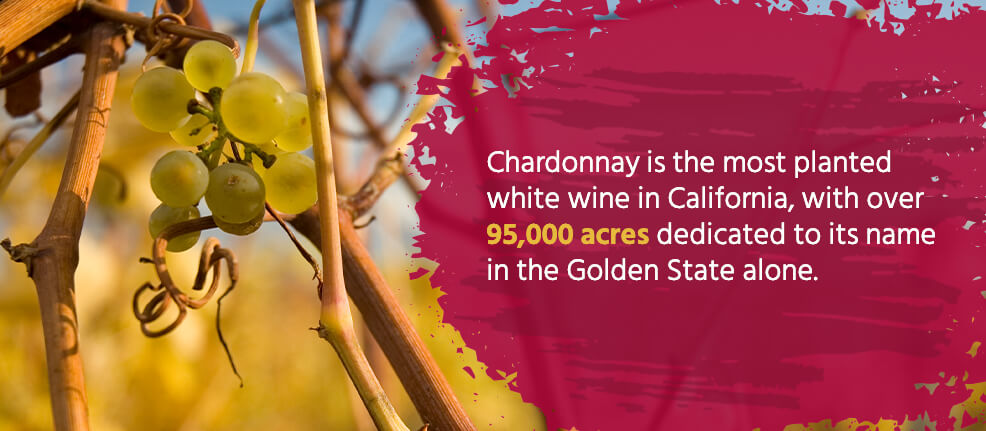
Today, chardonnay is one of the top-most planted white wine varietals around the world. In fact, chardonnay is the most planted white wine in California, with over 95,000 acres dedicated to its name in the Golden State alone.
Worldwide, chardonnay is grown and bottled in many other New World countries. Each micro appellation in these countries produces chardonnays with vastly different flavors, textures, structure and aromas, increasing the complexity behind the white wine. Some of the top countries that produce chardonnay today include:
- Australia
- Canada
- Chile
- New York State
- Oregon
- New Zealand
- Washington State
What Does Chardonnay Taste Like?
Given its relatively neutral base grape, there is no single set of characteristics defining all chardonnay. Instead, the flavors and smells noted while you drink will be affected by where the grape was grown (i.e., its primary flavors), then how the wine aged (i.e., secondary flavors).
Explore chardonnay’s primary and secondary to get an accurate taste description — and help you select your perfect chardonnay bottle.
1. Primary Flavors
In wine tasting, primary flavors are developed depending on the climate the grapes grew in — and the flavor of the grape directly influences the taste of the wine.
Chardonnay thrives in both warm and cool climates. Unlike other wine types — for example, the thick-skinned grenache, which needs hotter temperatures — chardonnays tend to be divided according to cool-climate or warm-climate origins. The nature of these growing conditions will create your chardonnay’s primary flavors.
- Primary flavors of cool-climate chardonnays: If you’re a fan of a citrusy chardonnay, it’s because an early harvest date and the cooler temperatures bring out the zest in the grape.
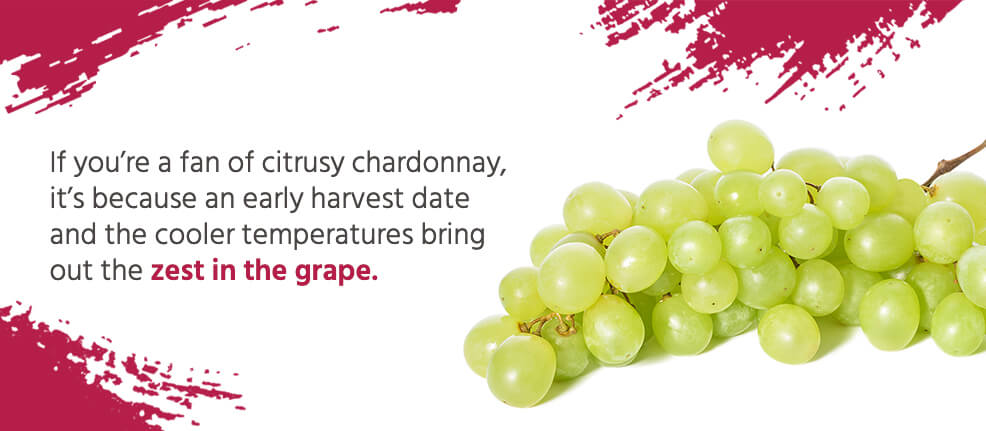
- Primary flavors of warm-climate chardonnays: Warmer climates allow chardonnay grapes to hang longer on the vine, therefore developing more sugar and reducing some of that pucker-worthy acidity. You’re left with a chardonnay that’ll be more mellow and rich. Like its cool-climate cousins, warm-climate chardonnays will still be fruit-forward, only you’ll experience more tropical ripe fruits, namely pineapple, kiwi and mango.
2. Secondary Flavors
Secondary flavors refer to how a wine tastes due to its aging and bottling techniques. These are the notes coaxed and controlled by the winemaker herself.
With chardonnay, the most common secondary flavors are developed through oak aging and/or malolactic fermentation. Both these treatments add depth and complexity to the fruity, dry chardonnay and work regardless of a warm or cool original climate.
- Oak-aged chardonnay: Chardonnay aged in oak is immediately recognizable due to secondary flavors of vanilla, coconut, praline and baking spices, as well as its heavier body. In other words, oak-aging chardonnay introduces a more dessert-like, caramel flavor profile to those primary fruit notes.
- Unoaked chardonnay: Unoaked chardonnay is fermented in stainless steel barrels, reducing the wine’s exposure to oxygen. With this fermentation method, unoaked chardonnay retains its light, fruit-forward notes and a pronounced, crisp and dry finish. You will not get creamy, dessert notes with an unoaked chardonnay.
- Malolactic fermentation (MLF): MLF typically occurs within oak barrels and brings a wine into contact with its lees, a mix of residual yeast and plant particles. The resulting flavor is what helps distinguish chardonnay from any other type of white wine — a notably buttery finish. Chardonnay that’s undergone MLF will be smoother, richer and creamier, creating truly one-of-a-kind glass of white wine.
3. Other Tasting Descriptions for Chardonnay
Consider the following characteristics to better determine your chardonnay’s flavor profile:
- Acidity: Chardonnay grapes are naturally dry and moderately acidic. Both warm and cool-climate chardonnays will retain that dryness and acidity. However, oak-aged and MLF chardonnay, with its buttery notes, will be noticeably less acidic than unoaked chardonnay.
- Body: All chardonnay contains a medium-to-full body, meaning its weight and texture will be firm and lush without veering heavy.
- Structure: Generally speaking, oaked chardonnay will have a higher ABV with bolder, boozier and deeper dessert-like flavors. Unoaked chardonnay will be lighter and elegant, with a lower ABV amount and a leaner, fruitier body.
- Mouthfeel: Unoaked chardonnay sips will feel relatively light and crisp. Oaked chardonnays, by comparison, will be smoother, softer and more rounded.
- Nose: Chardonnay’s natural aromas are delicate. Its most pronounced smells often match its primary fruits, giving off notes of fresh citrus to ripe tropical fruit. If oak-aged, the chardonnay will also carry hints of cream, vanilla, butter and baking spice.
- Finish: Nearly all chardonnay types — oak-aged and unoaked, cool and warm-climate — finish dry and clean.
How Many Calories in a Glass of Chardonnay?
A five-ounce serving of chardonnay wine will generally have around 120 calories. The average bottle of chardonnay contains about 625 calories.
Dry wines like chardonnay do carry a small amount of residual sugar. A trace amount of sugar means there are between 0-4 grams of carbohydrates per glass.
7 Types of Chardonnay
Types of chardonnay are best categorized according to warm versus cool climate, then old world versus new world origins. After all, these are the elements lending a bottle its primary and secondary flavors rather than the grapes themselves, ultimately contributing to chardonnay’s differences.
1. Burgundy Chardonnay: Old World, Cool Climate
Chardonnay is to Burgundy what Munich-brewed beer is to Oktoberfest. The two go hand-in-hand, with Burgundy’s green pastoral hills cloaking limestone-dominant soil where chardonnay thrives.
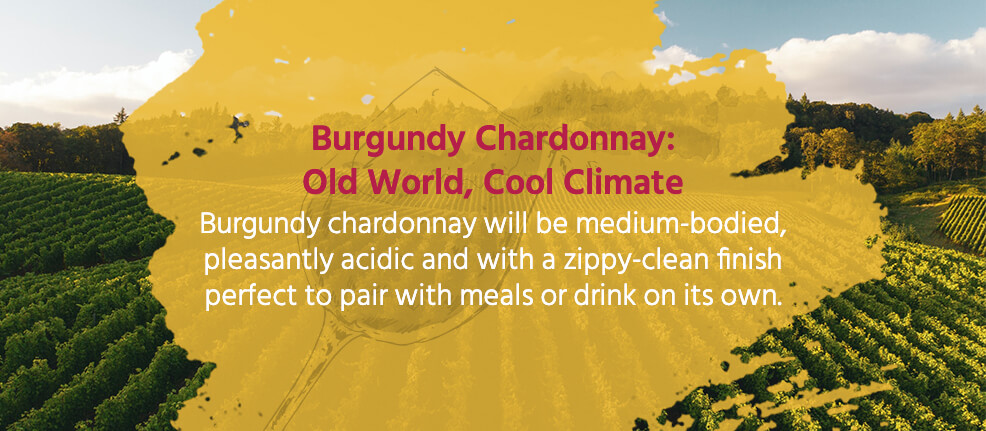
It’s this limestone-clay soil that gives Burgundy chardonnay its distinct, flint-like quality. These soft mineral notes add dimension to Burgundy chardonnay’s light, fragrant fruits, namely lemon, apple and melon. Burgundy chardonnay will also be medium-bodied, pleasantly acidic and with a zippy-clean finish perfect to pair with meals or drink on its own.
There are four major types of Burgundy chardonnay. To preserve its unique minerality, three of Burgundy’s Chardonnay — Bourgogne Blanc, Chablis and Mâconnais — tend to be unoaked. The fourth (and traditionally most expensive) Burgundy chardonnay, the Côte de Beaune, is oaked, resulting in that rich and buttery flavor profile with vanilla and truffle undertones.
Given its historical winemaking claim-to-fame, the region has a habit of sticking its name on top of all the types of wine it produces, which can cause confusion when you’re searching for a familiar varietal. For example, bottles of red wine from Burgundy are actually 100% pinot noir, while bottles of white wine from Burgundy are none other than chardonnay.
2. Champagne Chardonnay: Old World, Cool Climate
Yes, you guessed it. Champagne, France, is the home of its namesake drink, the bubbly white wine you pop on New Years, anniversaries, birthdays and other celebratory events. Sparkling champagne is, in fact, made from chardonnay-based grape blends. However, the same region produces its own type of chardonnay with distinct primary flavors and aromas.
Chardonnay from Champagne, France will be elegant, refined and semi-dry, pushing stone fruit flavors like peach and nectarine to the front of the palate. The cold, wet climate of this northern region shields the grapes’ natural acidity. Its unique porous and chalky soil also helps absorb some of the tangy minerality so pronounced in other French chardonnay, lending this type a rounder, smoother finish even when left unoaked.
3. Sonoma Valley Chardonnay: New World, Cool Climate
We can thank the Sonoma Valley for helping put California chardonnay on the map. The Northern region has 18 individual American Viticultural Areas (AVAs) and over 400 wineries, each with its own microclimate and terroir, producing some of the New World’s best chardonnay.
In fact, chardonnay is the most widely planted grape varietal in all of California. When unoaked, Sonoma Valley chardonnay is notably light, sweet and refreshing, featuring flavors of apricot, green apple and lemon zest. Oaked, this California chardonnay brings those signature vanilla, baking spice and butter notes so popular in this varietal, deepened by hints of cedar. Both types will carry high acidity, medium body and a lingering, mellow finish.
4. South African Chardonnay: New World, Warm Climate
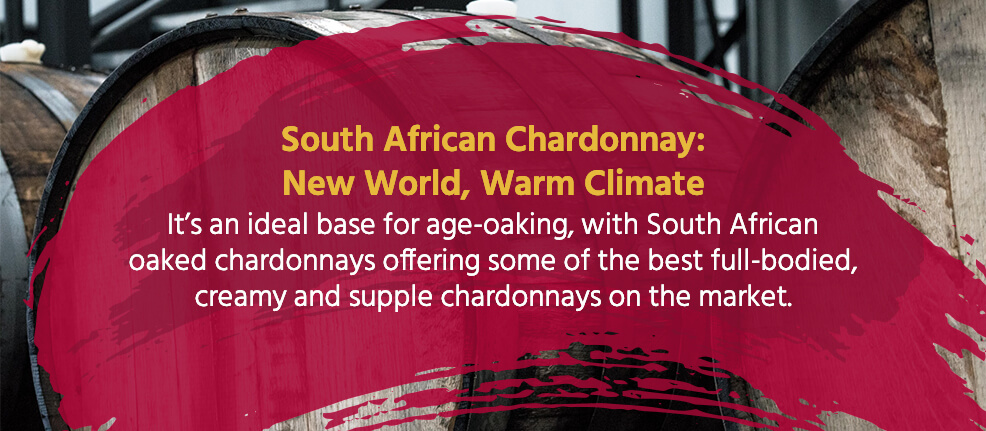
Chardonnay has found itself among the top white wine types grown in South Africa — and for a good reason. The warm, temperate climate punctuated by ocean-moderated rain and fog (particularly for vineyards near the coast) produces chardonnay grapes that are vibrant and complex but taut. It’s an ideal base for age-oaking, with South African oaked chardonnays offering some of the best full-bodied, creamy and supple chardonnays on the market.
Even oaked, South African chardonnays don’t lose their signature acidity. Expect flavors like pineapple, peach and fig mellowed by toasted nuts trailing the earlier sweetness and tang.
5. Willamette Valley Chardonnay: New World, Cool Climate
Oregon’s claim to chardonnay fame is perhaps best represented by Willamette Valley. Located in northwest Oregon — not far from major city centers like Portland and Eugene — Willamette Valley chardonnay is for those seeking the bright, refreshing stonefruit and citrus qualities innate to cool-climate chardonnay. The region’s chardonnay also contains a surprising blast of punchy minerals, which matures the acidity and make a bottle from this region particularly bright and energetic.
In fact, many have compared some of Willamette Valley’s best chardonnay wines with the flavors and aromas of white wine from Burgundy itself — the highest praise a New World chardonnay producer can get.
6. Italian Chardonnay: Old World, Cool (Northern Italy) and Warm (Southern Italy) Climates
Italian chardonnay is a world onto itself. The fourth-most planted varietal in the country, Italian chardonnay will vary in body, structure and acidity between the north and south, where varying climates and topographies create surprising grape profiles.
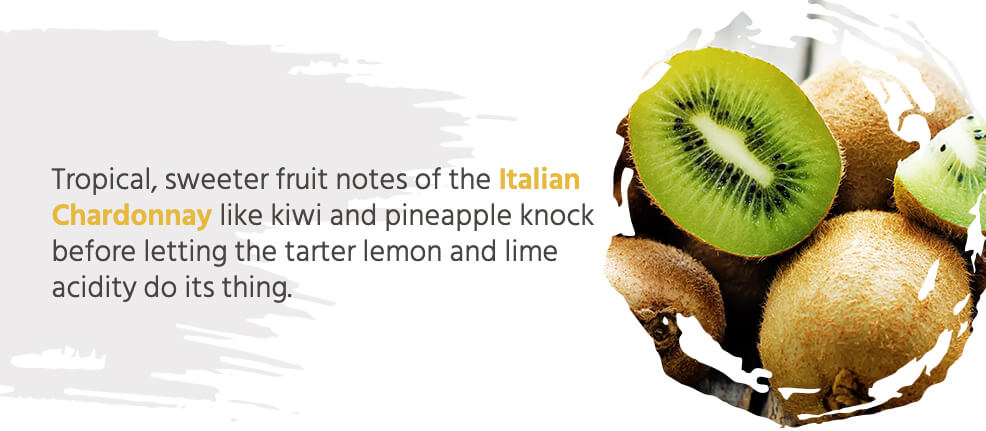
Southern Italian chardonnay from Sicily and Umbria are noticeably fleshier than its northern cousins. Tropical, sweeter fruit notes like kiwi and pineapple knock before letting the tarter lemon and lime acidity do its thing. When aged in oak, Italian wines carry a spiced uptick amplified by that acidity but not overwhelmed by it.
Northern Italian chardonnay from regions like Piedmont and Asti are lighter and sharper. Fruit flavors include lemon and white peach, with a medium body grounding the even when left unoaked. You’ll more readily find oak-aged Italian chardonnay hailing from the south, with northern growers overwhelmingly keeping their’s unoaked.
7. Australian Chardonnay: New World, Warm Climate
Australia offers one of the purest expressions of warm-climate chardonnay available today. The varietal is grown all over the Outback, yet arguably does best in the maritime climates of micro-regions like Margaret Valley, Adelaide Hills and the island of Tasmania.
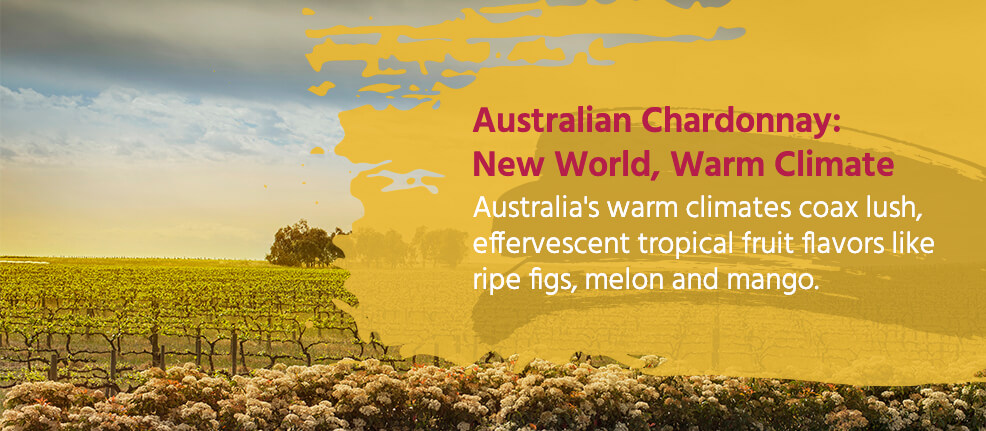
Australia’s warm climates coax lush, effervescent tropical fruit flavors like ripe figs, melon and mango. Australian chardonnay will also be softly structured but mouth-filling, with a round and velvety finish in both oaked and unoaked varieties. Premier Australian chardonnay varietals don’t rely on that one-note smoothness, though. Award-winning winemakers in Australia are adept at balancing its silkier finish with toasted nut, spice and vanilla notes to keep the flavors from falling too muted.
What Does Chardonnay Pair With?
Given the grape’s inherent neutrality, many foods pair well with chardonnay. However, it’s best to follow the “weight” rule of thumb when it comes to selecting a type of chardonnay to go with your dish: Heavier, richer oaked chardonnays go with heavier, richer meals while lighter, tarter unoaked chardonnay pairs great with light fare.
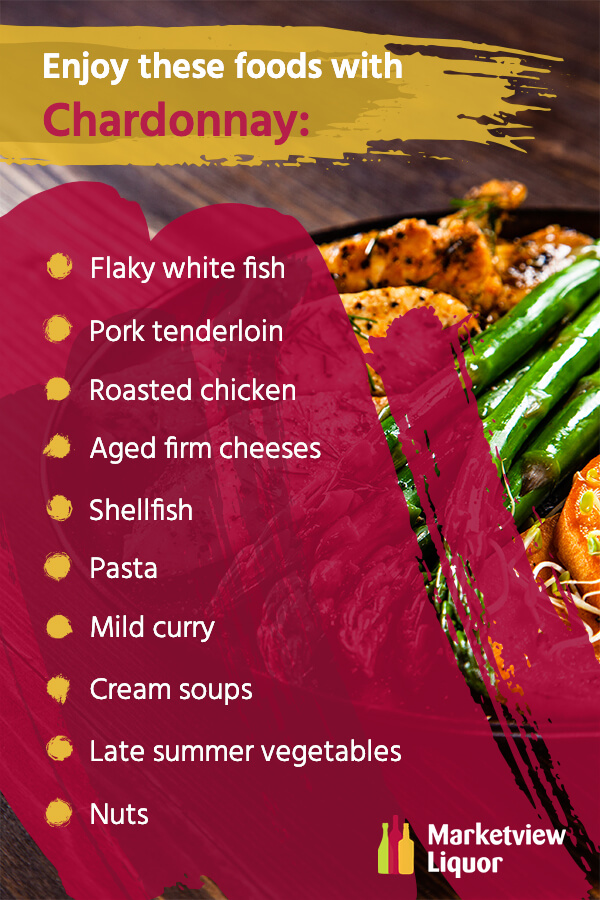
Enjoy these foods with chardonnay:
- Flaky white fish: Delicate but meaty white fish like halibut, cod and swordfish work great with both oaked and unoaked chardonnay — especially when poached and drizzled in a lemon-butter sauce.
- Pork tenderloin: An unoaked chardonnay uplifts juicy cuts of pork tenderloin. Get creative with your sauces. The pork-chardonnay pair makes a particularly great team with citrus glazes that amplify the pineapple and lemon-lime zest inherent to this white wine.
- Roasted chicken: Roasted chicken dishes, as well as other white-meat fowl, go great with the rich, creamy profile of oaked chardonnay. Try yours with a roasted mushroom cream sauce, caramelized onions or truffle shavings.
- Aged firm cheeses: Opt for semi-hard but creamy cheeses like Gruyère, Edam and Gouda. These selections amplify an oaked chardonnay’s nutty or toasted notes. But they’ll also be instantly brightened — but not overwhelmed — by a more acidic unoaked chardonnay.
- Shellfish: Few wine types pair as beautifully with shellfish as unoaked chardonnay. Think scallops, lobsters, crab and shrimp in a butter or béarnaise sauce featuring equally complimentary fare like sweet corn or roasted potatoes.
- Pasta: Pasta with butter or cream-based sauces is a go-to pairing for chardonnay. Select an oaked chardonnay for plates smothered in sauces, like carbonara or fettuccine alfredo, then a lighter, unoaked chardonnay for pasta featuring seafood.
- Mild curry: Oaked chardonnay is a delightful selection to pair with mild and yellow curries or similar dishes, like Indian malai kofta or butter chicken. The creaminess of the chardonnay enhances the coconut or yogurt bases of these dishes while letting their fragrant spices remain the stars.
- Cream soups: From hearty chicken dumpling or wild rice soups to flavorful Thai tom kha kai, go with an oaked chardonnay to complete the meal.
- Late summer vegetables: Squash, pumpkin, corn and parsnip puree can be paired with either heavier oaked or crisper unoaked chardonnay for a vegetarian feast.
- Nuts: Hazelnuts, macadamias, almonds and cashews carry an inherent creaminess perfect for chardonnay. Select either oaked or unoaked, old or new world when setting up your next charcuterie platter.
Always serve your bottle of chardonnay chilled, around 50–55°F. Once opened, flavors remain fresh for 2-4 days in the refrigerator before oxidizing.
Order Chardonnay Online
See for yourself why chardonnay is the most popular white wine type in the United States.
Marketview Liquor’s wine catalog has chardonnays from every corner of the world. Browse chardonnay online and select the bottles or brands you’d like. We’ll get your order shipped right to your door!

